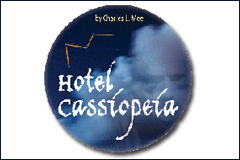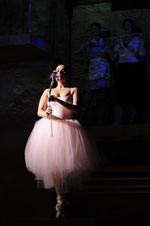 Now showing at the Don Powell Theatre at the San Diego State University campus, through December 7, 2008.
Now showing at the Don Powell Theatre at the San Diego State University campus, through December 7, 2008.
Sundays 2:00 p.m. all other days 8:00 p.m. For ticket information call 619-594-6884 or check online at www.theatre.sdsu.edu.
Charles L Mee's Hotel Cassiopeia follows the American collage artist Joseph Cornell. Cornell's dreamlike abstract art is the theme of the play, which is directed by Peter James Cirino. Characters in the play are reminiscent of people Cornell knew, observed or dreamed about. Mee created the play from diaries, letters, clips of Cornell’s life, and the music and movie he loved.
 |
| Photos provided courtesy of SDSU. Joseph Cornell and Lauren Bacall played by Phil Kruse and Annie Pritchard. |
 |
| The Ballerina is played by Diahanne McCrary. |
Why "Hotel Cassiopeia?" Cassiopeia, the constellation, is forever - Hotel Cassiopeiais a place you check into for a night or two. Come spend some time at a place between the two. Experience the world through the eyes of Joseph Cornell, played with sensitivity by Phil Kruse, as you become immersed in the many wonderful characters who filled his life: ballerinas, an actress, artists, friends, the women he teried to love, his mother who controlled him, and the sick brother to whom he was devoted.
The costumes were fantastic, which really made the story come alive. The ballerina was one of my favorites characters with Diahann McCrary doing all the magical dance moves every little girl dreams of in her beautiful pink costume. The cast is large and I'm sure you'll find your own favorite as you follow along the in the journey of Joseph Cornell's world.
Kathy Carpenter is a reviewer for San Diego Write Way and blogger for Eric Maisel Creativity Central blog.











